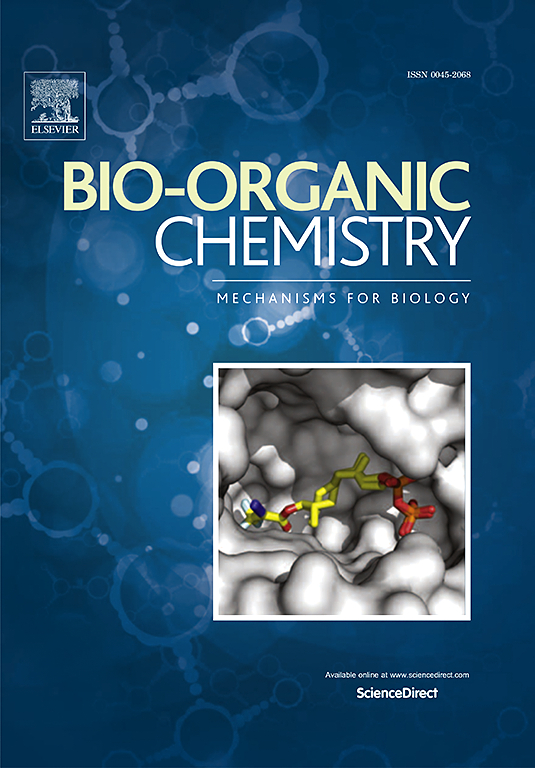探讨溴化乙胺作为离子液体在als连锁hSOD1 E49K突变体淀粉样蛋白聚集调节中的作用
IF 4.5
2区 医学
Q1 BIOCHEMISTRY & MOLECULAR BIOLOGY
引用次数: 0
摘要
离子液体(il)提供了一种多样化和可调节的方法来抑制淀粉样蛋白的形成,为开发针对淀粉样蛋白基础疾病的抗淀粉样蛋白药物提供了新的策略,正如蛋白质- il研究所探索的那样。本研究探讨了E49K突变体在淀粉样变性条件下淀粉样聚集体的形成,并评估了溴化乙胺(EABr)作为抗淀粉样变性药物与ALS病理相关的抑制潜力。通过分子动力学模拟、FTIR光谱、ANS荧光、ThT荧光和TEM成像研究了EABr的作用。通过ANS荧光监测,EABr通过减少E49K突变体聚集体中传染性疏水口袋的暴露来促进致密结构的形成。EABr以中等亲和力与E49K突变形式结合,通过稳定聚集易发区域抑制纤颤,如荧光猝灭所示。ThT荧光强度的降低和纤维形成的抑制以浓度依赖性的方式突出了EABr与E49K突变体在整个孵育期间的相互作用。饱和阶段的TEM图像提供了令人信服的证据,证明EABr抑制了E49K突变体中淀粉样蛋白原纤维的形成,从而支持了ThT分析结果。这些发现表明,EABr可以在体外抑制E49K SOD1突变体的淀粉样蛋白形成,支持其作为进一步药理研究的先导化合物的潜力。本文章由计算机程序翻译,如有差异,请以英文原文为准。

Exploring the role of ethylammonium bromide as an ionic liquid in amyloid aggregation modulation for ALS-linked hSOD1 E49K mutant
Ionic liquids (ILs) offer a diverse and tunable approach to inhibiting amyloid protein formation, providing new strategies to develop anti-amyloidogenic agents for amyloid-based diseases, as explored in protein-IL research. This study explores the formation of amyloid aggregates of the E49K mutant under amyloidogenic conditions and evaluates the inhibitory potential of ethylammonium bromide (EABr) as an anti-amyloidogenic agent relevant to ALS pathology. The effect of EABr was studied using molecular dynamics simulations, FTIR spectroscopy, ANS fluorescence, ThT fluorescence, and TEM imaging. EABr promotes the formation of compact structures by reducing the exposure of contagious hydrophobic pockets in the E49K mutant aggregates, as monitored by ANS fluorescence. EABr binds with moderate affinity to the E49K mutant forms, inhibiting fibrillation by stabilizing aggregation-prone regions, as shown in fluorescence quenching. The decrease in ThT fluorescence intensity and the inhibition of fibril formation in a concentration-dependent manner highlight the interaction of EABr with the E49K mutant throughout the incubation period. TEM images during the saturation phase provide compelling evidence that EABr inhibits the formation of amyloid fibrils in the E49K mutant, thus supporting ThT analysis results. These findings demonstrate that EABr can inhibit amyloid formation of the E49K SOD1 mutant in vitro, supporting its potential as a lead compound for further pharmacological studies.
求助全文
通过发布文献求助,成功后即可免费获取论文全文。
去求助
来源期刊

Bioorganic Chemistry
生物-生化与分子生物学
CiteScore
9.70
自引率
3.90%
发文量
679
审稿时长
31 days
期刊介绍:
Bioorganic Chemistry publishes research that addresses biological questions at the molecular level, using organic chemistry and principles of physical organic chemistry. The scope of the journal covers a range of topics at the organic chemistry-biology interface, including: enzyme catalysis, biotransformation and enzyme inhibition; nucleic acids chemistry; medicinal chemistry; natural product chemistry, natural product synthesis and natural product biosynthesis; antimicrobial agents; lipid and peptide chemistry; biophysical chemistry; biological probes; bio-orthogonal chemistry and biomimetic chemistry.
For manuscripts dealing with synthetic bioactive compounds, the Journal requires that the molecular target of the compounds described must be known, and must be demonstrated experimentally in the manuscript. For studies involving natural products, if the molecular target is unknown, some data beyond simple cell-based toxicity studies to provide insight into the mechanism of action is required. Studies supported by molecular docking are welcome, but must be supported by experimental data. The Journal does not consider manuscripts that are purely theoretical or computational in nature.
The Journal publishes regular articles, short communications and reviews. Reviews are normally invited by Editors or Editorial Board members. Authors of unsolicited reviews should first contact an Editor or Editorial Board member to determine whether the proposed article is within the scope of the Journal.
 求助内容:
求助内容: 应助结果提醒方式:
应助结果提醒方式:


